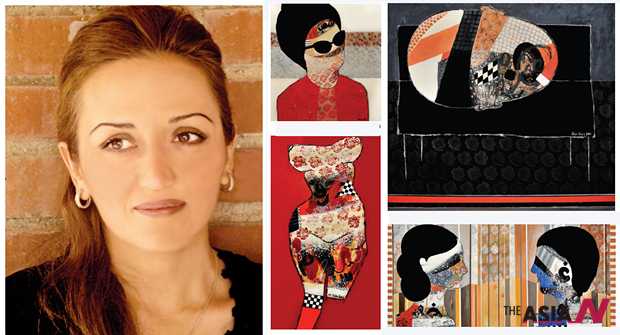Jordanian artist seeks to uncover secrets of circle

Adapting the circle and including discourse motifs are features of Hilda Hayari’s works. Messages, as shown in signs and flogs, in colours and letters are the tools of expression as well as the paste in colour tubes which artist Hilda Hayari turns into an opposing language of art.
*Editor’s note: This is the sixth and last installment of six-part stories about six Arab women artists devoting themselves to creating different style of art and innovating their methods of expression for “revolutionary” change.
Hilda Hayari “The Revolutionary Life Circle”
How does the circle control our imagination? It surrounds us as we try to fill our life circles with all the energy we have and discover the world’s circles with all our vision and insight. The approach to the circular forms – static and moving, fixed and changeable, tiny and huge, seen and hidden, self-explanatory and vague – may be an introduction to most of artist Hilda Hayari’s works. Let’s read her attempt to explain this circular approach to life and how it started with her journey:
“Many, including old philosophers, talked about the philosophical significance of the circle. Ever since my childhood and on many travels with my father, and even in my country, I have been looking at points and holes and watching lines on sand and rocks. My favourite play has been with ants, watching them move together, touching and letting them move on my hand, looking with enjoyment at those tiny creatures building their circular homes on sand. Reading also has made me engaged in thinking and discovery all the time, looking for the significance and many meanings of these lines and circular shapes. On my travels around the world to share in regional and international exhibitions, and due to the endless spirit of enlightenment and discovery, my lifelong endeavour has been to explore everything new, particularly in art.”
The Jordanian young girl Hilda uncovered the endless secrets of the circle which she carried until she became a prominent artist. These are the secret about her many works and different stages in her career, a world of rich, colour and captivating circles, a formation on the painting space, which creates an integrated world, cities of stereotyped circles which, as I started following up her career a decade ago, looked like globules in plasma, turning in due course into living robots on the painting.
When she designed a 150-meter mural in central Amman, which took a whole month to complete, she did not forget her favourite circular icons swimming in the water of life, adding symbolic lines and shapes of people, filling the painting with noise, motion and colour. The circle is also present in this mural setting the time of completion of each part of the mural mosaic of colours and life which is filled with white and red tiny organisms, creating chaos and order at the same time, as if they were us before being created human beings.
The third circle appears anew, this time like empty heads, as she screened a videotape of empty fezzes, which won the first prize in synthesis at the tenth Cairo Biennale (2006). It was there that the feminine – and human – revolution against heavy heads was launched: a female face with clouds of smoke passing through heavily coloured red lips and filling an area where a group of masculine silent headless red fezzes sit, with a hollow tailed circular cylinder turning the circular head.
In the same year Hilda won the painting prize at the twelfth Asia Biennale organized by Bangladesh, where the circle featured again, with different symbols and explanations, sometimes looking like a galaxy with multi-energy, multi-layered colours.
Her works are a big bang with planetoids and starlets; maybe an atom with its protons and electrons, or a hurricane carrying our missing objects in space; possibly reducing the news to a group of carrings, as if the news wanted someone to listen to, circular rings for news which we orbit, as it presents and documents our diaries lest we should forget them.
Ideas get ahead of works, works race against time to keep up with Hilda Hayari’s ideas. Raw materials are readily and voluntarily available for her in her atelier in whose silence she produces a growling sound like a volcano, which travels around the world presenting an alphabet of a human multi-cultural art, even if using Arabic letters, for her letters are part of the never-ending boisterous revolutionary life circle.














































































